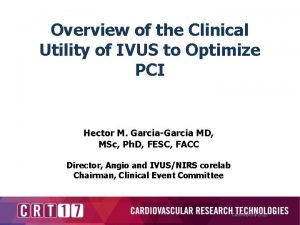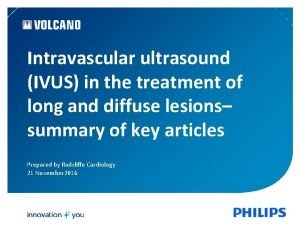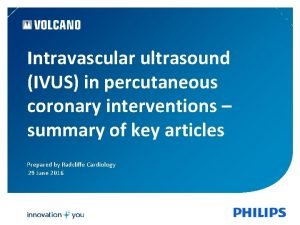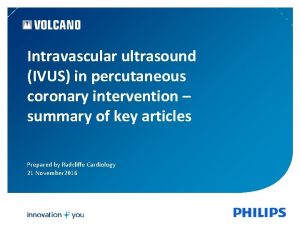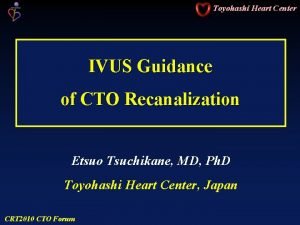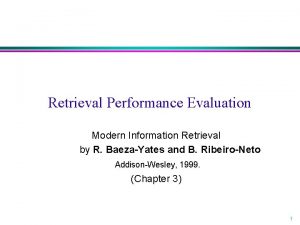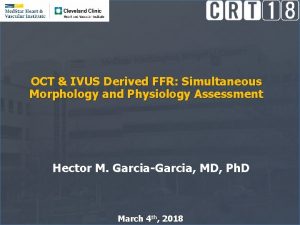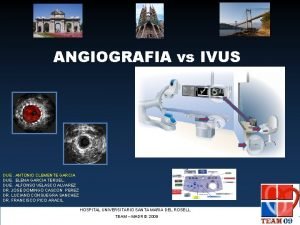High Definition HD IVUS A New Approach to






















- Slides: 22

High Definition (HD) IVUS: A New Approach to Improve Conventional IVUS Neil J. Weissman, MD Med. Star Health Research Institute Washington Hospital Center Washington, D. C. Disclosures - Institutional Grant Support from Boston Scientific

State of IVUS - 2010 • IVUS technology has been clinically available for almost 20 years. Yet. . . - Image quality has not improved in the last 10 years. - Poor spatial resolution and catheter-to-catheter imaging inconsistency are problematic. - Current IVUS systems are not capable of resolving structures <100 μm in size (thin cap fibroatheroma). - Poor image quality often requires expert interpretation, inhibits confidence in new users, and is a primary obstacle to maximizing growth and adoption of IVUS technology.

But what if. . • What if we could start from scratch to design an IVUS system – transducer, catheter interface, console, etc – using 2010 technology as well as 20 years of knowledge. . . What would this system look like? • However, building a high-definition image requires optimizing the entire system. Improvements to any one system component (e. g. , transducer) may enhance performance, but not optimizing each component of the imaging chain will not yield the targeted improvements.

What determines image quality? Pulse Duration Frequency Transducer Bandwidth Image Quality Signal/Noise Ratio Pulse Length Transducer shape

But, how is image quality defined? Temporal Resolution Image Quality Contrast Resolution Axial Resolution Lateral Resolution Penetration

What is resolution? • Axial resolution is the ability to distinguish echoes from reflectors which are closely spaced along the ultrasound beam axis. Shorter wavelengths (higher frequencies) improve axial resolution. • Lateral resolution is the ability to distinguish echoes from reflectors which are closely spaced on an axis perpendicular to the ultrasound beam axis. - Near zone (Fresnel zone): beam width is essentially the same as the transducer diameter. - Far zone (Fraunhofer zone): beam width diverges. • Contrast resolution is the ability to distinguish differences in the strength of echoes returning from different types of reflectors. Transducer sensitivity, system signal integrity, analog-to-digital conversion, grayscale compression curves, and display monitor properties impact contrast. • Temporal resolution is the ability to generate and receive echoes faster than the motion of the reflectors. The maximum imaging distance (limited by speed of sound in tissue) combined with the number of scan lines per frame determine the frame rate.

Transducer • The ultrasonic transducer is the heart of the system. No amount of signal processing can overcome poor signal fidelity from the transducer. • Standard measures of performance of ultrasonic transducers are pulse width and fractional bandwidth. • A well-designed imaging transducer is sensitive over a broad band of frequencies. • Well-designed ceramic transducers are capable of fractional bandwidths >50%, yet current IVUS transducers have fractional bandwidths <35%.

Transducer • Axial resolution is improved by increasing the frequency domain (fractional bandwidth) of the transducer and by shortening the time domain (impulse) response • Lateral resolution is improved by increasing the effective aperture (surface area) and focusing the transducer (concave surfaces). However, larger transducer sizes must be balanced against the increases size of the catheter. • Sensitivity is the efficiency of the conversion from an electrical impulse to an acoustic wave (transmit) and vice versa (receive). Improved sensitivity results in better signal to noise ratio and increases penetration.

Transducer Commercial Transducer #2 (B) Spherically-focused Polymer Film Transducer • Second generation transducers will incorporate new materials and geometries. Several candidate materials that are currently under investigation include thin and thick film piezoelectric materials and composite materials. Chandrana et al. , IEEE Ultrasonics Symposium, 2007

Transducer Single Flat Transducer Dual Transducer • Second generation HD-IVUS transducers may also include dual transducer configurations that will be optimized for very broadband imaging applications, including harmonic imaging, and multiband fusion imaging.

Multifrequency Imaging 60 MHz 20 MHz Cross. Correlation of the two Frequencies

Harmonic imaging to detect vasorum by contrast bubble targeting Transmit Receive Before Injection After Injection One hypothesis is that Vasa Vasorum density correlates with the amount of inflammation and hence vulnerability of the lesion. during injection

Catheter and System Interface • Necessary catheter improvements - Improved handling performance - Elimination of imaging core wind up - Resolved flushing issues - Improved transducer connections - Decreased resistance - Improved reliability • Improved catheter/system interface - High definition resolution - Reduced image acquisition time - Support for higher frequency devices

Front End Innovations: Transducer BSC 40 MHz Transducer Small Bandwidth – Less Information Lower Frequency – Less Separation SVMI 60 MHz Transducer Assembly Stack (0. 6 mm x 0. 4 mm) Large Bandwidth – More Information Higher Frequency – More Separation Confidential

Coherence Imaging Information-rich images enable substantial image enhancements through vector domain signal processing for mechanically rotating imaging catheters (4096 scan lines of information as compared to 256 -512)

Comparison of In Vitro Human Cadaver LAD Segment Commercial 40 MHz (135 microns resolution) Confidential SVMI 40 MHz (80 microns resolution) 11/30/2020 16

Comparison of In Vivo Stent Malapposition in Porcine Model B: 0. 17 mm A: 0. 12 mm Light. Lab™ Image. Wire OCT (with saline flush) Confidential SVMI HD-IVUS 50 MHz (in blood) 11/30/2020 17

Comparison of In Vivo Stent Malapposition in Porcine Model B: 0. 17 mm A: 0. 12 mm Commercial 40 MHz Confidential A: 0. 12 mm SVMI HD-IVUS 50 MHz 11/30/2020 18

Product Performance Comparison SVMI HD-IVUS BSC i. Lab / Atlantis Volcano s 5/Revolution Console OS Linux Windows XP Imaging Frequency 10 -80 MHz 10 -45 MHz System Topology Direct RF Baseband Scanning Mechanism Mechanical Analog to Digital Converter 14 -bit 400 MS/s 12 -bit 200 MS/s 12 -bit 40 MS/s Digital Signal Processor Xilinx Virtex 5 Xilinx Virtex 3 Transducer Bandwidth 30 MHz 13 MHz 11 MHz Axial Resolution 50 μm 150 μm 200 μm Lateral Resolution 100 μm 400 μm Maximum Pullback Rate 20 mm/sec 1. 0 mm/sec Maximum Frame Rate 160 FPS 30 FPS Catheter Dead Zone 15 mm 25 mm 32 mm Catheter Coating Hydrophilic Hydrophobic

Superior Catheter Design Dead Zone Length SVMI • Tip shape • Wire channel • Telescope • Dead zone length • Extra length • Hydrophilic coating Boston Scientific Volcano 15 mm 25 mm 32 mm

In Vitro Human Cadaver Image Comparison Commercial 40 MHz Confidential SVMI 60 MHz 11/30/2020 21

Simultaneous Multi-Frequency Operation Images acquired with the same catheter SVMI 60 MHz catheter @ 60 MHz Confidential SVMI 60 MHz catheter @ 40 MHz 11/30/2020 22
 Ivus
Ivus Intravascular ultrasound
Intravascular ultrasound Ivus
Ivus Ivus
Ivus Ivus
Ivus Ivus ffr
Ivus ffr New-old approach to creating new ventures
New-old approach to creating new ventures Comparison of virtual circuit and datagram networks
Comparison of virtual circuit and datagram networks Theoretical models of counseling
Theoretical models of counseling Michael treacy and fred wiersema
Michael treacy and fred wiersema Multiple approach-avoidance
Multiple approach-avoidance Bandura's reciprocal determinism
Bandura's reciprocal determinism Research approach meaning
Research approach meaning Traditional approach to system development
Traditional approach to system development Tony wagner's seven survival skills
Tony wagner's seven survival skills Word power: a new approach for content analysis
Word power: a new approach for content analysis A new approach to cross-modal multimedia retrieval
A new approach to cross-modal multimedia retrieval A whole new approach
A whole new approach New approach directives
New approach directives High precision vs high recall
High precision vs high recall High precision vs high recall
High precision vs high recall Directive behavior
Directive behavior High expectations high support
High expectations high support
